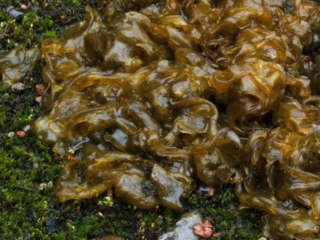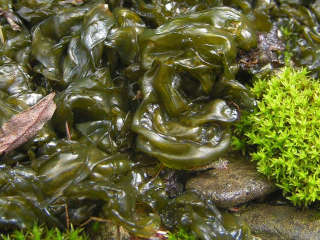 Inspect Septic Drainfield Soil Condition
Inspect Septic Drainfield Soil Condition
Wet Soils & Nostoc commune = Evidence of Septic System Failure
- POST a QUESTION or COMMENT about how soil conditions can indicate failure of a septic drainfield or soakaway bed
This septic drainfield article series discusses the evaluation of drainfield soil conditions among the types of causes of septic system failure in the drain field, leach field, seepage bed, or similar component.
We also discuss what can be planted over and near a septic drainfield and what should be avoided.
We list the causes of each type of septic component failure, and list the septic component failure criteria or in other words what conditions are defined as "failure"? How can you distinguish between a blocked pipe, a septic tank that needs pumping, and a clogged drainfield that needs replacement? This is an important question as it distinguishes between relatively low cost maintenance or repair task and a costly septic leach field replacement.
InspectAPedia tolerates no conflicts of interest. We have no relationship with advertisers, products, or services discussed at this website.
- Daniel Friedman, Publisher/Editor/Author - See WHO ARE WE?
Septic Drainfield Soil Conditions & Liquid Level
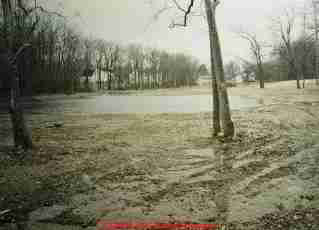 The absorption system or "drain field" has two jobs
The absorption system or "drain field" has two jobs
First, it disposes of liquid effluent by permitting it to seep into the soil below.
Second, it treats the sewage pathogens: a "bio-mat" of bacteria that forms in the soil below the drainage field processes pathogens in the septic effluent to make the effluent sufficiently sanitary as to avoid contaminating nearby ground water.
This distinction between successful "disposal" and successful "treatment" is important to avoid groundwater contamination but has not been addressed by regulation in every municipality.
[Click to enlarge any image]
Watch out: If a septic soakbed like the new septic drainfield in our photo is wet with standing water, ever, it is not working, not effective, and is improperly designed or installed, or has failed.
Municipalities which require a minimum distance between the bottom of the drain field trenches (or equivalent component) and the top of the seasonal high ground water table have recognized the importance of a working bio-mat and the need to provide adequate dry soil for it to function.
Even in a well-designed drainage field, eventually the soil surrounding the drainfield device (perforated pipe in gravel trench or other seepage system) becomes clogged with grease and debris.
Examining an excavated cross-section of a failed drainfield
Examining an excavated cross-section of a failed drainfield will often display a black or gray band of sludge and grease of about 1" thickness at the inside perimeter of the gravel trench. When this layer of soil becomes sufficiently clogged the passage of effluent into the soil below is slowed and eventually blocked, leading to the need for replacement. Keeping a tank pumped so as to reduce the passage of debris and grease into a drain field will extend its life.
This is the most expensive problem to correct. Look for septic effluent seepage to ground surface in area of equipment or downhill from such equipment.
Look for (illegal) drain field line extensions to nearby streams, storm drains, or adjoining properties where the temptation to "fix" a failing system by sending the effluent to an improper destination overwhelmed a previous owner or repair company.
In some areas where septic inspections are commonly performed, septic system inspectors use septic loading and dye test. Seepage may be due to overloaded tank, failed absorption system, or blocked/broken piping (may be less costly).
An excavator or septic contractor will often explore one or more drain lines (or similar components) by excavating a portion of it to look for evidence of flooding or soil clogging. We've used a simple probe at the end and along a leach bed to check for flooding of that component. (Be careful not to break or collapse old piping.)
Fungus, Slime Mold, Cyanobacteria in the Drainfield: Signs of Trouble?
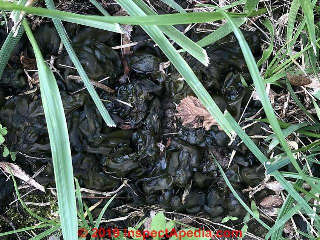 Question: Identify this black, brown, tan, yellow or other rubbery stuff in my yard
Question: Identify this black, brown, tan, yellow or other rubbery stuff in my yard
On 2019-06-22 by gkw1944 - what is this black curdled rubbery plastic-like stuff appearing in my septic leach field?
I have been finding this unusual material on my leach field. Black curdled plastic/rubber stuff. It has no smell and does not appear to be waste. I called several septic companies no one responds. Should I call a plumber instead?
I have discovered what looked like black curdled rubber/plastic in my leach field. I am attaching picture. No smell as if a waste product. Don’t know who to call.
Have made a few calls to Septic people. No one responds. Is it better to call a plumber?
[Click to enlarge any image]
This Q&A were posted originally
at SEPTIC FAILURE CRITERIA - signs of trouble with the septic drainfield -
and some reader follow-up comments were originally posted at SEPTIC DRAINFIELD FAILURE CAUSES - what causes a septic drainfield to fail.
On 2019-06-23 by (mod) - animal droppings or algae / fungus
Tell me the country and city where you live and tell me whether it's not a rather rural area. I suspect that that's animal droppings. At least that's what your photo looks like. In Northern Minnesota I've seen bear poop that looks a lot like your photo - more images would be helpful. Other possibilities are an algae / cyanobacteria or slime mold or other fungus like organism.
On 2019-06-23 by Gkw44 - not animal droppings
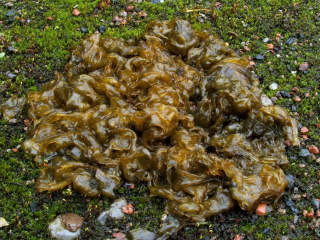 Kingman Indiana. Yes rural, not like any animal droppings I’ve ever seen. It is only in the grass in various areas of the leach field. I separated with a stick. It almost looks like plastic and has green algae or mold on it. My septic system is an Equalizer 36 Chamber installed in 2002.
Kingman Indiana. Yes rural, not like any animal droppings I’ve ever seen. It is only in the grass in various areas of the leach field. I separated with a stick. It almost looks like plastic and has green algae or mold on it. My septic system is an Equalizer 36 Chamber installed in 2002.
Only one resident using this system 6 months a year.
Had it pumped last summer and service man said there were a lot of tree roots, which he cleared at entry point. I have no issues inside my home. Getting a lot of standing water .. due to a lot of rain I guess.
[Photo: this cyanobacteria also grouped with the algae looks like animal poop or a fungus; it is found in a range of colors including black, brown, and green as we illustrate above and below - Nostoc commune. Photos: Lairich Rig, CC BY-SA 2.0, https://commons.wikimedia.org/w/index.php?curid=14219869 retrieved 2019/07/28]
But just wash 1 load of clothes and standing water even after several dry days. Stuff I am seeing has no texture or smell. No flies hovering around. I’ve had creatures big and small leave droppings on my deck and in garden. Nothing that looks like the picture I sent. I put Root Rid in the toilet several weeks ago, not sure how effective that stuff is though.
Have had several neighbors look at it and they are just as baffled. Started thinking I had a problem when grass in this area started dying. Still trying to have a septic person come out and assess, if I can get one to return a phone call.
Thanks for the response.
When it was pumped the water was backed up all the way to the septic access lid. Serviceman said the holding tank appears to be blocked from tree roots. Not sure I can go about cutting down huge trees that are scattered about the property to keep roots out.
The black stuff is certainly on the surface, and not coming thru the ground. Ever since system was pumped I get standing water at the access lid which is 12” below ground. Will hopefully find a place to have it analyzed and get someone out here. Trying to resolve these issues on my own, and worried I will be told to replace the entire system. Have no issue with doing that just want to be sure it is necessary. Thanks again
. Love this site and your quick responses. Will keep you updated once I can get someone out here. I have been calling septic companies... should I call a professional plumber instead?
On 2019-06-26 by Gkw44 - Nostoc commune is an algae - not quite a fungus - looks like bear poop
Adding an update to previous inquiry and picture of black stuff on my leach field
It is a black mold/ fungus called Nostoc Commune..star jelly, witches brew. Etc. evidently it appears after a lot of rain which we have had this season here in Indiana. It could appear anywhere according to what I’ve read. Also impossible to get rid of. Unless weather gets drier.
Had an assessment of my leach field and it appears it is failing and also probably illegal today.
I’m looking at having a complete new system installed though our lots are small and getting something that is the correct distance from the well could be problematic.
Means water and sewage lines and holding tank might be moved into front yard. Obviously excavation of my property is not something I want to do. I was told that if I wanted to sell my home septic system would not be approved by any bank inspection. Had a feeling this was coming.
On 2019-07-03 by (mod) - black stuff on the leachfield is a cyanobacterium Nostoc commune
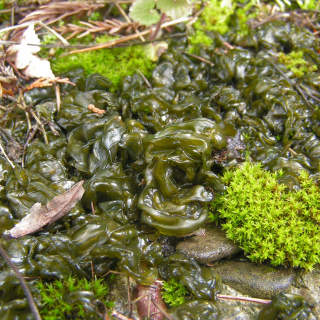 Thanks for the follow up that's very interesting. Nostoc commune is an algae or more properly, a cyanobacterium - not quite a fungus, certainly not animal poop, and common in wet lawns in North America. Thank you for pointing it out.
Thanks for the follow up that's very interesting. Nostoc commune is an algae or more properly, a cyanobacterium - not quite a fungus, certainly not animal poop, and common in wet lawns in North America. Thank you for pointing it out.
Nostoc commune is ubiquitous, world wide, and has been studied for at least two hundred years. (Wright 2001). It's a remarkable cyanobacteria that may be both toxic to humans and other animals, has been eaten by some as food, and appears also to have antibiotic properties useful against certain forms of acne. (Itoh 2014).
Watch out: Nostoc commune itself is unlikely to be having any effect whatsoever on the septic drainfield. However its presence on your septic drainfield is diagnostic: either your septic drainfield is flooded by wet weather - a design and installation failure, or your field is in failure from blockage and effluent keeping the ground surface wet - a drainfield failure in both cases.
Nostoc grows in soil areas where there is at least sometimes standing water. When this cyanobacterium is found growing on a drainfield that means that the field is too wet and is flooding; conditions that flood the field would make the field in fact not functional.
A properly-constructed septic effluent disposal field or leachfield will have at least two feet between the bottom of the actual drainfield trench and the top of the seasonal high water table.
It is possible to get rid of Nostoc growing in your yard by raising the ground surface and improving drainage but that's not a good solution for a septic drainfield where you don't want to increase the depth of the leach lines (depriving the necessary soil bacteria of oxygen). For a septic field the very least you'd do would be to re-route surface runoff well away from the drainfield area.
Others trying to get rid of Nostoc have experimented with algaecides (limited effectiveness), herbicides like Roundup® (worse than ineffective, stimulates growth), herbicidal soaps (limited effect), and Scythe (pelargonic acid) an herbicide that was found effective but only on wet, non-dormant forms of Nostoc and, of course, also killing off everything else growing in the area including preferred grasses and ground covers. (Boggs 2019).
For other readers, here we post two additional photos useful for identifying the Nostoc commune. Photos: Lairich Rig, CC BY-SA 2.0, https://commons.wikimedia.org/w/index.php?curid=14219869 retrieved 2019/07/28
A Taxonomy of Nostoc commune - properly a cyanobacterium.
Adding to public confusion over identifying this common growth is the fact that Nostoc commune is a blue-green algae, a cyanobacterium that is also referred to as a photobiont or a mycobiont. Nostoc is probably best grouped as a bacteria,
- Genus Cyanobacteria, family Nostocacae, order Nostocales, species: Nostoc commune.
Nostoc will appear in some mushroom identification texts (among the algae) and in some lichens identification texts as is often grouped with the lichens.
Popular names for Nostoc commune include facai, fah-tsai, mare's eggs, star jelly, witches brew, witches' butter. In some parts of the world it's eaten as a food. However,
Watch out: some texts point out that Nostoc genus organisms are considered capable of producing active secondary metabolites that are highly toxic to humans and other animals. Don't eat it. (Nowruzi 2012).
Lichens are a group of roughly 15,000 biological forms with similar properties and that do not fit neatly into the taxonomy of living things - a sort of hybrid life form that is itself is an odd organism: a symbiotic association between a fungus and an alga or cyanobacterium. (Cyanobacteria are considered a blue-green alga.)
Research on Nostoc commune
- Boggs, Joe, "The Inside Story on Obnoxious Nostoc" [web article] Ohio State University Extension, College of Food, Agricultural, and Environmental Sciences, 10 May 2019, retrieved 2019/07/28, original source: https://bygl.osu.edu/node/1258
This article includes helpful photographs of Nostoc commune in various conditions including both wet and healthy and dried-out, flattened forms. - Ehling-Schulz, Monika, Wolfgang Bilger, and Siegfried Scherer. "UV-B-induced synthesis of photoprotective pigments and extracellular polysaccharides in the terrestrial cyanobacterium Nostoc commune." Journal of Bacteriology 179, no. 6 (1997): 1940-1945.
- Itoh, Tomohiro, Akihiro Tsuchida, Yuji Muramatsu, Masayuki Ninomiya, Masashi Ando, Yasuyuki Tsukamasa, and Mamoru Koketsu. "Antimicrobial and anti-inflammatory properties of nostocionone isolated from Nostoc commune Vauch and its derivatives against Propionibacterium acnes." Anaerobe 27 (2014): 56-63.
Abstract Propionibacterium acnes is the primary pathogenic agent responsible for acne vulgaris on the skin and hair follicles. Overgrowth of this bacterium inhibits growth and promotes follicular inflammation, with an associated increase in pro-inflammatory cytokine production. P. acnes has therefore been considered the main target for the prevention and medical treatment of acne vulgaris.
The aim of this study was to evaluate the in vitro anti-P. acnes and anti-inflammatory properties of 6 compounds isolated from Nostoc commune. One of these compounds, nostocionone (Nost), and one of its derivatives, NostD3 [(1E,4E)-1-(3,4-dihydroxyphenyl)-5-(2,6,6-trimethylcyclohex-1-enyl)penta-1,4-dien-3-one], significantly inhibited P. acnes growth. Furthermore, we investigated the effects of Nost and NostD3 on heat-killed (hk) P. acnes-induced inflammation in macrophages.
Both Nost and NostD3 suppressed hk P. acnes-induced nitric oxide (NO) production through the suppression of inducible NO synthase expression, following inactivation of nuclear factor kappa B. Taken together, our findings suggested that both Nost and NostD3 were promising agents for the treatment of acne vulgaris, and that NostD3 showed higher efficacy than Nost. - Nowruzi, Bahareh, Ramezan-Ali Khavari-Nejad, Karina Sivonen, Bahram Kazemi, Farzaneh Najafi, and Taher Nejadsattari. "Identification and toxigenic potential of a Nostoc sp." Algae 27, no. 4 (2012): 303-313.
Abstract: Cyanobacteria are well known for their production of a multitude of highly toxic and / or allelopathic compounds. Among the photosynthetic microorganisms, cyanobacteria, belonging to the genus Nostoc are regarded as good candidate for producing biologically active secondary metabolites which are highly toxic to humans and other animals.
Since so many reports have been published on the poisoning of different animals from drinking water contaminated with cyanobacteria toxins, it might be assumed that bioactive compounds are found only in aquatic species causes toxicity.
However, the discovery of several dead dogs, mice, ducks, and fish around paddy fields, prompted us to study the toxic compounds in a strain of Nostoc which is most abundant in the paddy fields of Iran, using polymerase chain reaction and liquid chromatography coupled with a diode array detector and mass spectrophotometer. Results of molecular analysis demonstrated that the ASN_M strain contains the nosF gene.
Also, the result of ion chromatograms and MS2 fragmentation patterns showed that while there were three different peptidic compound classes (anabaenopeptin, cryptophycin, and nostocyclopeptides), there were no signs of the presence of anatoxin-a, homoanatoxin-a, hassallidin or microcystins. Moreover, a remarkable antifungal activity was identified in the methanolic extracts.
Based on the results, this study suggests that three diverse groups of potentially bioactive compounds might account for the death of these animals. This case is the first documented incident of toxicity from aquatic cyanobacteria related intoxication in dogs, mice, and aquatic organisms in Iran. - Tamaru, Yoshiyuki, Yayoi Takani, Takayuki Yoshida, and Toshio Sakamoto. "Crucial role of extracellular polysaccharides in desiccation and freezing tolerance in the terrestrial cyanobacterium Nostoc commune." Appl. Environ. Microbiol. 71, no. 11 (2005): 7327-7333.
- Wright, Deborah, Todd Prickett, Richard F. Helm, and Malcolm Potts. "Form species Nostoc commune (Cyanobacteria)." International Journal of Systematic and Evolutionary Microbiology 51, no. 5 (2001): 1839-1852.
Abstract: The form species concept for the Cyanobacteria was evaluated using a comprehensive set of Nostoc samples that were collected during the past two centuries, from all continents, including regions from the Tropics to the Poles. Phylogenies were constructed based upon the conserved regions of tRNALeu (UAA) group I intron DNA sequences.
Thirty-four forms contained a tRNALeu (UAA) intron of 284 nt. These 284-nt introns contained 200 nt of conserved sequence that, in most cases, shared 100% sequence identity, they had three variable regions (I, II and III) amounting to 84 nt, contained no hypervariable region and formed a discrete cluster in phylogenetic analysis.
These forms represented 31 independent populations in both hemispheres and constitute examples of form species Nostoc commune. Multiple introns were obtained from several of the populations. Ten populations contained introns of 287-340 nt with a hypervariable region, 8 to 59 nt in length, located between variable regions I and II. Alignments identified 15 examples where 5'-AAAAUCC-3' occurred at the hypervariable region-variable region II boundary; this sequence is identical to the conserved sequence at the 3' intron-exon boundary (splice site) within the tRNALeu (UAA) gene.
The possibility that hypervariable regions were removed from the primary intron through secondary splicing was tested in vitro but proved to be negative under the experimental conditions used. Shared morphologies of genetically different strains, dissimilar morphologies in strains that share identical genetic markers, incorrect naming of culture collection strains and genetic drift in cultured strains emphasize that the successful delineation of cyanobacterial species requires the application of multiple taxonomic criteria.
On 2019-06-23 by (mod) - when do you need a plumber or septic repair contractor
GK
Other than animal droppings there could be a fungus growth in your yard - that's not something that is per-se a sign of a septic failure. You don't need a plumber
- to deal with a growth that's on just the yard surface
- that is not due to a septic failure
- when there are no indoor trouble signs like slow drains, sewage smells indoors, backing up drains, drain noises
- no outdoor sepic failure signs such as those given
at SEPTIC FAILURE CRITERIA
When a septic drainfield fails enough to show up on the yard surface it's more likely to be as a wet area that smells of sewage.
However if roots are invading your septic system, cleaning the will give only temporary relief and ultimately you'll need to remove the root sources, keeping those plants a safe distance away - take a look
at TREES or SHRUBS OVER THE SEPTIC FIELD or TANK
We need clarification on what was pumped and where roots were found in your septic system. Pumping a tank, necessary to preserve drainfield life, never ever fixes a clog or performance issue.
Similarly, removing roots will remove a clog in a drain line but never ever will fix the underlying problem of root invasion. Removing roots from inside of a drain line leaves their source, more roots from a living plant, just a fraction of an inch away. They'll be back. Root killers are also not, in my opinion, an effective solution. Instead one needs to remove the source plants and keep them away from the drainfield. Search InspectApedia.com for PLANTS OVER DRAINFIELDS to read details.
I'll send your photo to a mycologist to ask if it looks like a fungus.
You might use a clean gallon freezer type ZipLok bag, collect a sample of your mystery mateiral, and bring it to your local county farm and home center or consulting agency for identification. Keep me posted.
On 2019-06-26 by Gkw44 - the rubbery stuff in the yard over the septic is Nostoc Commune..star jelly, witches brew - etc.
Adding an update to previous inquiry and picture of black stuff on my leach field
It is a black mold/ fungus called Nostoc Commune..star jelly, witches brew. Etc. evidently it appears after a lot of rain which we have had this season here in Indiana. It could appear anywhere according to what I’ve read. Also impossible to get rid of. Unless weather gets drier.
Had an assessment of my leach field and it appears it is failing and also probably illegal today. I’m looking at having a complete new system installed though our lots are small and getting something that is the correct distance from the well could be problematic. Means water and sewage lines and holding tank might be moved into front yard.
Obviously excavation of my property is not something I want to do. I was told that if I wanted to sell my home septic system would not be approved by any bank inspection. Had a feeling this was coming.
On 2019-07-03 by (mod) - Nostoc commune - Witches butter - Black Jelly Roll fungi, slime molds, cyanobacteria in your yard - it's not bear poop
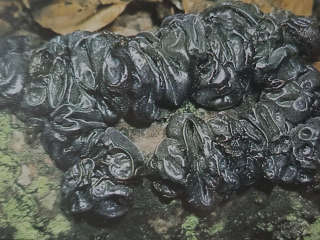 Thanks for the follow up that's very interesting. Nostoc commune is an algae - not quite a fungus, certainly not animal poop, and common in wet lawns in North America.
Thanks for the follow up that's very interesting. Nostoc commune is an algae - not quite a fungus, certainly not animal poop, and common in wet lawns in North America.
Thank you for pointing in out. It's unlikely to be having any effect whatsoever on the septic drainfield. However that conditions that flood the field would make the field in fact not functional.
Lawn Algae, Nostoc Algae: Nostoc commune:
Nostoc commune is often more tan in color and is perhaps an algae not a fungus. Nostoc algae.
Similar possibilities for your fungus that looks like animal drippings include among the slime molds and jelly fungi, "Black Jelly Roll",Exidia glandulosa, among the Tremellacae, Tremellales, found throughout North America - National Audubon Society Field Guide to Mushrooms, 1981, (below) - some sources say this is edible raw as a "survival food" though growing in septic effluent would make that not something I'd recommend.
Conversely "Witches butter" is yellow, a slime mold, and looks entirely different. (Orange Jelly Fungus
Scientific Name: Dacrymyces palmatus Phylum: Basidiomycota - and hence a different fungus).
(In my opinion the common name given to you "Witches Brew" probably refers to this same fungus.)
Other Darker algae or slime molds that may be found in lawns or woodlands and that may look like animal droppings, moose poop, bear poop, etc.
Black Witch's Butter, Exidia glandulosa, - Barron, George, Mushrooms of Northeast North America, Lone Pine Field Guide 1999.
Though you'll notice that those tend to be more homogeneous in color.
More-accurately, Star jelly, witch's butter, mare's eggs, fah-tsai or facai are all names for a cyanobacterium Nostoc commune in the family Nosocaceae. - Wikipedia 2019. The two illustrations below, public domain fdrom the Wikipedia article
https://en.wikipedia.org/wiki/Nostoc_commune illustdrate that this slimy algae-like growth can appear in a range of colors including black, dark brown, greenish algae-like coloured, to tan or even almost translucent with little pigment when the growth is young.
Why would you find flourishing Nostoc commune over the septic field? It may like the extra nitrogen in soil where sewage effluent is present, though it can in fact get its own nigrogen from the air as well.
Nostoc commune or witch's butter is in fact, ubiquitous, growing eveen in polar regions and near-desert areas where the soil is quite dry, it likes and tends to flourish where there is fresh (not salt) water, wet areas, and on soil, gravel, even pavement where you might also find moss.
It's not a true fungus, it's not a mold, and though it looks like bear poop, it's not.
...
Continue reading at SEPTIC FAILURE CRITERIA - signs of a septic system failure, or select a topic from the closely-related articles below, or see the complete ARTICLE INDEX.
Or see these
Recommended Articles
- DRAINFIELD RESTORATION APPROACHES
- SEPTIC DRAINFIELD INSPECTION & TEST - home
- PLUMBING DRAIN NOISE DIAGNOSIS.
- SEPTIC DISPOSAL FIELD CLOGGING INSPECTION
- SEPTIC DRAINFIELD FAILURE CAUSES
- SEPTIC DRAINFIELD FAILURE DIAGNOSIS
- SEPTIC FAILURE CRITERIA
- SEPTIC FAILURE LAWSUIT
- SEPTIC FAILURE SIGNS
- SEPTIC FAILURE SPOTS
- SEPTIC ODORS INDICATING DRAINFIELD FAILURE
- SEPTIC TANK GRASS or SNOWMELT
- SEPTIC TROUBLE SIGNS, OTHER
- SOAKBED SOIL CONDITIONS
- SEPTIC & CESSPOOL SAFETY
- SEPTIC DRAINFIELD LIFE
- SEPTIC DRAINFIELD LOCATION
- SEPTIC DRAINFIELD RESTORERS?
- SEPTIC TESTS: DYE & LOADING TESTS
- SEPTIC SYSTEM ODORS
Suggested citation for this web page
SOAKBED SOIL CONDITIONS at InspectApedia.com - online encyclopedia of building & environmental inspection, testing, diagnosis, repair, & problem prevention advice.
Or see this
INDEX to RELATED ARTICLES: ARTICLE INDEX to SEPTIC SYSTEMS
Or use the SEARCH BOX found below to Ask a Question or Search InspectApedia
Ask a Question or Search InspectApedia
Try the search box just below, or if you prefer, post a question or comment in the Comments box below and we will respond promptly.
Search the InspectApedia website
Note: appearance of your Comment below may be delayed: if your comment contains an image, photograph, web link, or text that looks to the software as if it might be a web link, your posting will appear after it has been approved by a moderator. Apologies for the delay.
Only one image can be added per comment but you can post as many comments, and therefore images, as you like.
You will not receive a notification when a response to your question has been posted.
Please bookmark this page to make it easy for you to check back for our response.
IF above you see "Comment Form is loading comments..." then COMMENT BOX - countable.ca / bawkbox.com IS NOT WORKING.
In any case you are welcome to send an email directly to us at InspectApedia.com at editor@inspectApedia.com
We'll reply to you directly. Please help us help you by noting, in your email, the URL of the InspectApedia page where you wanted to comment.
Citations & References
In addition to any citations in the article above, a full list is available on request.
- Our recommended books about building & mechanical systems design, inspection, problem diagnosis, and repair, and about indoor environment and IAQ testing, diagnosis, and cleanup are at the InspectAPedia Bookstore. Also see our Book Reviews - InspectAPedia.
- In addition to citations & references found in this article, see the research citations given at the end of the related articles found at our suggested
CONTINUE READING or RECOMMENDED ARTICLES.
- Carson, Dunlop & Associates Ltd., 120 Carlton Street Suite 407, Toronto ON M5A 4K2. Tel: (416) 964-9415 1-800-268-7070 Email: info@carsondunlop.com. Alan Carson is a past president of ASHI, the American Society of Home Inspectors.
Thanks to Alan Carson and Bob Dunlop, for permission for InspectAPedia to use text excerpts from The HOME REFERENCE BOOK - the Encyclopedia of Homes and to use illustrations from The ILLUSTRATED HOME .
Carson Dunlop Associates provides extensive home inspection education and report writing material. In gratitude we provide links to tsome Carson Dunlop Associates products and services.


